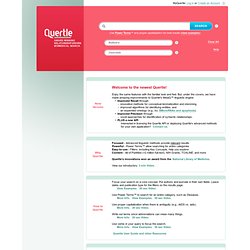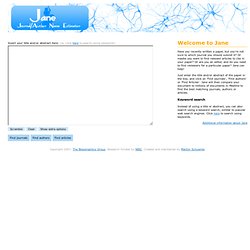Zoom
Trash

GoPubMed® - Transinsight's semantic search for the life sciences. PubMed PubReMiner: a tool for PubMed query building and literature mining. MEDIE. MEDIE is an intelligent search engine to retrieve biomedical correlations from MEDLINE, based on indexing by Natural Language Processing and Text Mining techniques. You can find abstracts/sentences in MEDLINE by specifying semantics of correlations; for example, "What activates p53" and "What causes colon cancer". Semantic search is to use a semantic query for finding biomedical correlations. Input a subject, a verb, and an object of a concept (or either of them) into a form. Results of the query will be shown in a second.
Examples: "What does p53 activate? " A GCL query is directly passed to a GCL server. The customization of the number of results is available as in Semantic Search. A list of GCL operators: Go to top This system is provided by the Tsujii Laboratory "AS IS" without warranty of any kind. This system is built on the Medline database leased from the National Library of Medicine [NLM]. NLM represents that its data were formulated with a reasonable standard of care. MedNar. PubMed Reader. ScienceRoll Medical Search. XTractor. BioMedLib™ Whatizit. Unbound MEDLINE. PubViz. In short, PubViz is developed to provide the capability of utilizing external knowledge as well as interactive visual query functions for more efficient exploration of the Medline database.

The current version has the ability to utilize protein-protein interaction data during Medline search and enable researchers to identify functionally related Medline records not retrievable in existing search engines. It can also utilize the structure relationship of different type of genetic markers including cytobands, microsatellite/STS markers, SNPs and genes derived from human genome assembly and HapMap data for deep search of genetically related Medline records. We include many visualization functions in PubViz, such as interactive PMID, MeSH, Gene views, the transition between different views, selection of node description display on network graph, as well as details of abstract and sorting/filtering functions.
(Please note: PubViz is currently development. Quertle. To find the most focused results, Quertle searches for assertions made by the author(s) that tie all of your search terms together in a meaningful way.

Thus, it is best to focus your initial query on the core concepts of interest, such as "what causes B". Then, add additional terms, such as "mice", and dates when you filter the results. Authors and journals should be entered into their own search boxes. Example use this: caffeine treats migraines instead of this: caffeine treats migraines in mice 2009 Smith As you type, automatic suggestions will appear. Start typing a name to display a list of authors. Separate multiple authors by a comma. Start typing to display a list of journals. Separate multiple journals by a comma. This tab displays documents where the author(s) made a statement connecting your search terms together in a meaningful way. As you filter the results, the number will update. To remove any filter, click its When multiple filters are applied, all can be removed using the. Pubget. PubFocus. PubCrawler Web Service. LigerCat.
Journal / Author Name Estimator (Jane) Insert your title and/or abstract here: (or, click here to search using keywords) Have you recently written a paper, but you're not sure to which journal you should submit it?

Or maybe you want to find relevant articles to cite in your paper? Or are you an editor, and do you need to find reviewers for a particular paper? Jane can help! Just enter the title and/or abstract of the paper in the box, and click on 'Find journals', 'Find authors' or 'Find Articles'. Keyword search Instead of using a title or abstract, you can also search using a keyword search, similar to popular web search engines. HubMed. FABLE. CoPub.